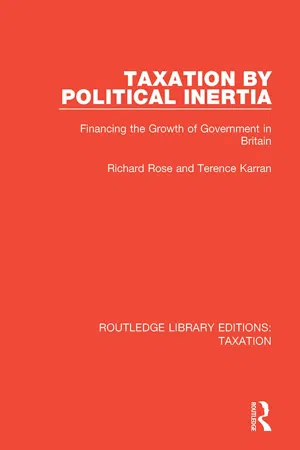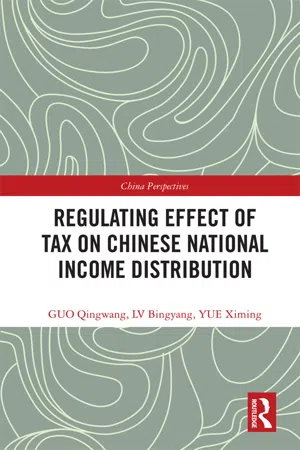Economics
Types of Taxes
Taxes can be categorized into different types based on the entities they are imposed on and the purposes they serve. Common types of taxes include income tax, which is levied on individuals and businesses based on their earnings; sales tax, imposed on the purchase of goods and services; and property tax, which is based on the value of real estate or personal property.
Written by Perlego with AI-assistance
Related key terms
Related key terms
1 of 4
Related key terms
1 of 3
9 Key excerpts on "Types of Taxes"
- Gary Bandy(Author)
- 2014(Publication Date)
- Routledge(Publisher)
It is conceivable, and perhaps likely, that when a government imposes each new tax it does so for a discrete purpose (e.g. Tax A is to raise income; Tax B is for regulation and so on) but over time all new taxes become established, part of the whole system of taxes and part of the political decision-making process. This means that the purpose of the tax may evolve, perhaps developing a hybrid purpose. It is, if nothing else, easier for a government that wishes to implement a policy change to consider whether it can achieve the desired effect by adjusting an existing tax rather than creating a new one. An example of this is the changes to the standard rate of VAT in the UK between 2008 and 2011.The basic rate of VAT in the UK had been 17.5 per cent since 1991 but was lowered to 15 per cent (the rate it had been from 1979 until 1991) in December 2008 for a fixed period of 13 months. The reason for this was to stimulate the economy in response to the global recession by reducing the retail price of many goods and services. In June 2010 the Chancellor of the Exchequer George Osborne announced that the standard rate would rise to 20 per cent from January 2011, a change in the rate that was expected to yield an additional £13 billion a year. Osborne (2010 ) said, ‘That is thirteen billion pounds we don't have to find from extra spending cuts or income-tax rises’, indicating that the purpose of the increase was to generate income.Types of Taxes
Taxation is a subject rife with jargon. This section explains various Types of Taxes and what is meant by terms like direct, indirect, progressive, regressive, equitable, efficient and buoyant when used to describe a tax. First, taxes can be classified into four types: income, consumption, wealth and poll taxes.Income taxes
Income taxes are taxes levied on earnings and in this context income would include earnings from overseas interests and income from investments and savings as well as the salary or wages received from paid work. Examples include personal income tax for individuals and corporation tax for businesses.- eBook - ePub
Public Sector Revenue
Principles, Policies and Management
- Alberto Asquer(Author)
- 2017(Publication Date)
- Routledge(Publisher)
Contemporary tax systems are populated by a variety of taxes, which include, for example, personal income tax, corporate income tax, sales tax, VAT, excises, custom duties, stamp tax and so on. Some taxes have been levied for many years, like, for example, the personal income tax in the UK, which was first established by William Pitt the Younger in 1798 to pay for preparation for the Napoleonic Wars and that, after a number of periods when it was repealed, became a stable component of the British tax system during the nineteenth century. Other taxes have been introduced relatively recently, like, for example, VAT which was first established in France in 1954 and then spread throughout most countries in the world. Sometimes, however, taxes are short-lived: for example, in 2015 the Punjab government of Pakistan introduced a 19.5% tax on Internet connections, which was repealed after some months following popular protest.A broad distinction is commonly made between two Types of Taxes, namely direct and indirect ones (Atkinson, 1977). Direct taxes are paid directly from taxpayers to imposing entities. They consist of levies that are based on the economic conditions related to an entity (an individual or a legal entity), such as their income or property. Examples of direct taxes include personal income tax, corporate income tax, property tax, inheritance tax and social security (e.g. National Insurance contributions in the UK). Indirect taxes, instead, are paid indirectly from the bearer of the ultimate tax burden to imposing entities through an intermediary. They consist of levies that are based on economic events, such as acts of production and transaction of goods. Indirect taxes are typically collected and paid by an entity (such as the producer of a good or a merchant) although the actual cost of the tax is charged to another entity (typically the final consumer of the good). Examples of indirect taxes include sales tax, VAT, excises and custom duties.Nowadays most countries in the world employ a mix of direct and indirect forms of taxation. But which one of the two forms of taxation is preferable? Before addressing this question, which has attracted considerable attention in the scholarly literature (Atkinson and Stiglitz, 1976; Auerbach, 1985; Cremer and Gahvari, 1995; Cremer et al., 2001; Martinez-Vazquez et al., 2011), a distinction should be drawn between progressive and regressive - eBook - ePub
- Neva Goodwin, Jonathan M. Harris, Julie A. Nelson, Pratistha Joshi Rajkarnikar, Brian Roach, Mariano Torras(Authors)
- 2018(Publication Date)
- Routledge(Publisher)
Fortunately, one need not comprehend the imposing complexity of tax laws to understand the crucial role of taxes in modern societies. Taxation is an important topic for students of economics. Tax policies have important economic consequences, both for a national economy and for particular groups within the economy. Tax policies are often designed with the intention of stimulating economic growth—although economists differ significantly about which tax policies are most effective at achieving this. Taxes can create incentives promoting desirable behavior and disincentives for unwanted behavior. Taxation provides a means to redistribute economic resources toward those with low income or special needs. Taxes provide the revenue needed for important public services such as social security, health care, national defense, and education.Taxation is as much a political issue as an economic issue. Political leaders have used tax policy to promote their agendas by initiating various tax reforms: decreasing or increasing tax rates, changing the definition of taxable income, creating new taxes on specific products, and so forth. Of course, no one particularly wants to pay taxes. Specific groups, such as corporations, farmers, or retired individuals, exert significant political effort to reduce their share of the tax burden. Tax codes are packed with rules that benefit certain groups of taxpayers while inevitably shifting more of the burden to others.In this chapter, we take a look at taxes and tax policy. First, we consider taxes from a theoretical perspective based on the economic models from earlier chapters. Second, we summarize the different Types of Taxes, with an emphasis on the United States. Third, we present an international comparison of tax policies. Finally, we address current tax debates, including the distribution of the tax burden among different groups.1 . Economic Theory and Taxes1.1 Taxes in the Supply-and-Demand ModelThe supply-and-demand model we presented in Chapter 3 can be used to gain insights into the effects of taxation on consumers and producers. To incorporate taxes into our model, we consider a per-unit tax on a product or service, referred to as an excise tax - eBook - ePub
- Rob Dransfield(Author)
- 2013(Publication Date)
- Routledge(Publisher)
To raise revenue. The earliest taxes were raised by governments to pay for the expenses of the rulers of a country and to finance wars. Today, taxes are levied to raise money to cover a range of government expenditures – for example, on building schools, hospitals and roads, paying for defence and a police force.To discourage certain activities – for example, those that some see as anti-social in terms of the damage to health and pollution that they cause, such as smoking or driving. So cigarettes, cars and fuel may be heavily taxed.To discourage the import of goods. Import taxes are referred to as tariffs. They can be levied as a percentage of the value of imports (an ad valorem tax) or a set tax on each item imported (a specific tax).- To redistribute income from the rich to the poor.
Economists make a distinction between:- Direct taxes, for which the burden falls on the person paying it – for example, when you pay income tax it is taken directly from your wages and paid to the government.
- Indirect taxes, which are imposed by governments on goods and services, but are eventually paid by consumers rather than by businesses that collect the tax for the government in the first instance.
The payer of a direct tax has no choice about whether they pay the tax. In contrast, consumers can decide whether or not to buy a good with a tax on it. Because of this element of choice some people believe that the government should rely more on indirect than direct taxes. For example, Conservative governments in Britain have always favoured indirect taxes such as VAT rather than direct taxes such as income tax (which it sees as a disincentive to work).Progressive, regressive and proportional taxes If income is going to be redistributed then the rich need to pay more in tax than the poor.A progressive tax takes a greater proportion of income from a wealthy person than from a poor person. So someone earning £20,000 a year might pay 15 per cent tax on this income (£3,000), someone earning £50,000 a year might pay 20 per cent tax on this income (£10,000) and a person earning £100,000 a year 25 per cent tax on this income (£25,000). In each case the richer the person the more disposable income that they have after tax (see Table 14.4 - eBook - ePub
- Subhajit Basu(Author)
- 2016(Publication Date)
- Routledge(Publisher)
Chapter 3International Taxation: Indirect TaxationIntroduction
Taxation has either direct or indirect effects on almost every aspect of production and distribution in modern economies.1 Taxes such as tax on goods and services which include general sales tax, VAT, excise duty, import and export duties form the indirect taxes. These taxes are an important source of revenue for most of the governments around the world. They either follow the European model of VAT or the US model of sales tax. VAT is an indirect, multi-stage consumption tax. As an indirect tax , the VAT is levied upon the articles of trade before they reach the customer, who eventually pays the tax-inclusive market price. The label ‘indirect’ follows from the fact that the payer of the VAT does not suffer a corresponding reduction in their income from such purchases. VAT is insensitive to the individual circumstances of the taxpayer following from its ‘indirectness’ and it is not an effective means of redistribution. Sales tax is a tax on the retail sale of specified tangible property or services, which have historically been sold over the counter to the buyer and collected at the location where the good is transferred from the seller to the buyer. This will include personal property and in some cases intangible property is also subject to sales tax as tangible personal property, for example computer software is sometimes considered tangible and therefore taxable. Real property is usually not subject to sales tax, but may be subject to transfer tax. Three factors determine whether sales tax liability in a particular state exists for a transaction: (i) the type of good being sold; (ii) situs - eBook - ePub
Taxation by Political Inertia
Financing the Growth of Government in Britain
- Richard Rose, Terence Karran(Authors)
- 2018(Publication Date)
- Routledge(Publisher)
Viewing taxation as a means of raising revenue concentrates attention upon one particular aspect of a tax: how much money does it raise? This introduces a sense of proportion. From a revenue perspective, one tax that raises a large sum of money is worth more attention than dozens of taxes that contribute very small sums to the fisc. The first section of this chapter examines the multiplicity of taxes. The three succeeding sections review in detail the multiplicity of laws that define taxes; the administrative institutions that collect taxes; and the different types of economic activity subject to taxation. The chapter concludes by comparing the sums contributed to the fisc by millions of taxpayers with the benefits that ordinary citizens receive from programmes financed by taxation.Many TaxesDefining TaxesIn generic terms taxes are ‘compulsory, unrequited payments to general government’ (OECD, 1984a: 39). The first distinguishing feature of a tax is that it is compulsory. Only government can levy taxes, because only the state can compel people to do what they would not voluntarily do. The second feature of taxes is that they are unrequited – that is, the payments are not exchanged for particular goods or services. In the market, a person paying money receives something specific in return but nothing specific is given in exchange for the payment of a particular tax. Benefits of public policy are normally not contingent upon the payment of particular taxes.There are hundreds of different ways of collecting money. The International Monetary Fund (1983: 284f., 77f.) reports forty-eight different taxes in use in Britain, and 137 different taxes in France, including three different taxes on pari-mutuel betting. The more taxes that are enumerated the smaller the proportion of money that the average tax can contribute to the fisc. In the case of France, eighty-two of the taxes each produce less than 0.01 per cent of revenue.The most comprehensive single catalogue of British taxes is that contained in the National Accounts, which lists taxes under thirty-eight different headings that vary enormously in money value. The criterion used for selecting a tax as suitable for analysis here is that it accounted for at least 1 per cent of total tax revenue in at least one year since 1948. So low a threshold ensures the inclusion of taxes that may have interesting attributes, even though (or because) they are relatively small in money raised. Taxes that contribute less than this amount, such as a variety of customs and excise taxes, are aggregated under a single heading (for further details, see Appendix A, and Rose and Karran, 1983:10ff.). - eBook - ePub
- Robert E. Wright, Thomas W. Zeiler(Authors)
- 2014(Publication Date)
- CQ Press(Publisher)
Lost in this discussion, however, have been concerns about simplicity and revenue sufficiency, as the tax system has grown ever more complex since 1986 and the amount of tax revenue collected has fallen well short of government expenditures in recent years. These two factors will no doubt set the stage for the debates that are yet to come.SOURCES OF FEDERAL TAX REVENUEThe federal government in the United States relies on six major Types of Taxes: the individual income tax, payroll taxes, the corporate income tax, the estate tax, excise taxes, and customs duties and fees.The individual income tax is levied on all sources of income, including wages and salaries; farm, business, and rental income; investment income (including interest, dividends, and capital gains); and other sources. In figuring income tax liability, taxpayers add up all of their sources of income, then subtract a number of adjustments to income (including some education, moving, retirement, and health-related expenses), to yield their adjusted gross income. Taxpayers then subtract either a standard deduction or the total amount of itemized deductions (including medical expenses, state and local income taxes, mortgage interest, charitable donations, and a number of other deductions) and subtract a dollar amount for each exemption that they claim. The result is the taxable income. Finally, taxpayers use a graduated tax schedule in which the marginal tax rate, the tax rate on an additional dollar of income, increases in steps as taxable income increases, to calculate their regular income tax liability. The range of incomes to which a particular marginal tax rate applies is called a tax bracket.Higher income taxpayers must also calculate tax liability in an alternative way by adding back some of the deductions and exemptions and by applying a different rate schedule. If the result of this calculation is higher than their regular income tax liability, they must pay the difference in the form of the Alternative Minimum Tax.Finally, a number of credits are allowed against an individual’s tax liability, including the foreign tax credit, credit for child and dependent care expenses, Child Tax Credit, and the Earned Income Tax Credit (EITC). Some of these credits are payable even if the credit exceeds the taxpayer’s income tax liability.2 - Qingwang Guo, Bingyang Lv, Ximing Yue(Authors)
- 2019(Publication Date)
- Routledge(Publisher)
Since China builds the tax shifting model with the input-output table, and the latest input-output table is the data in 2007, we analyze the urban and rural tax burden with the data in 2007. The tax categories levied by the tax department in 2007 include the value-added tax, consumption tax, business tax, enterprise income tax, income tax of foreign-invested enterprise and foreign enterprise, personal income tax, resource tax, adjustment tax on orientation of fixed assets investment, urban maintenance and construction tax, house property tax and urban real estate tax, stamp tax, urban land use tax, land value increment tax, vehicle and vessel tax, vehicle purchase tax, tobacco tax, etc. The tax data used by us is the tax income organized by the tax department, excluding the tariff and other non-tax income levied by the tax department, such as education surcharges, income from cultural undertakings construction fee, social insurance fund and other incomes.As stated in the previous chapter, the personal income tax is usually considered to be directly undertaken by the individual, and with regard to the tax incidence of enterprise income tax, the consensus of opinion is lacked in the literature, therefore, this chapter will not deeply involve. We mainly analyze the distribution situation of final incidence of indirect tax and its incidence between urban and rural residents. In the literature, the indirect tax refers to the tax paid by the enterprise and levied to the commodity and service. Here, we take other taxes as the indirect tax, except for the direct tax. Therefore, the value-added tax, business tax, consumption tax and resource tax are not only included, but also the adjustment tax on orientation of fixed assets investment, urban maintenance and construction tax, house property tax and urban real estate tax, stamp tax, urban land use tax, land value increment tax, vehicle and vessel tax and other taxes are included. These taxes are mainly paid by the enterprise, and we assume that they are forwardly shifted to the consumers. Therefore, the indirect tax here can be taken as the generalized indirect tax.- Holley Ulbrich(Author)
- 2013(Publication Date)
- Routledge(Publisher)
- Taxes on sales are primarily a state and local revenue source in the United States. Sales taxes are appealing because transactions offer a convenient tax handle. They also permit tax collectors to tap one of the three measures of ability to pay (consumption) and provide a way of exporting some taxes to nonresidents.
- The types of sales taxes that are in widespread current use around the globe are retail sales taxes, selective sales or excise taxes (including tariffs), and value-added taxes. Sales taxes can be single- or multi-stage, broad-based or narrowly focused, or levied on either the buyer or the seller.
- The retail sales tax is more elastic in the short run than the long run, making revenue vulnerable to economic downturns but relatively insensitive to long-term growth.
- Sales taxes, particularly selective ones, tend to erode their bases over time as consumers shift their purchases to untaxed goods and services or untaxed markets. Distortions of decision making are increased by any compounding or cascading, including retail sales taxes on business purchases.
- Sales taxes are regressive. The regressivity can be reduced by broadening the base; narrowing the base by eliminating certain consumption items; using excise taxes on items consumed more by higher-income individuals; and/or rebating some of the sales tax through means-tested income tax relief.
- Efficiency issues specific to the retail sales tax include the taxation of business inputs and the incomplete coverage of consumption, both of which distort location decisions and allocation of consumer spending among various goods and services.
- Excise taxes are used for revenue, to reduce the regressivity of the retail sales tax by imposing higher taxes on luxuries, and to discourage undesirable activities. Excise tax rates tend to be higher than typical retail sales tax rates and cause more deadweight loss.
- Value-added taxes have come into use in a large number of countries since the 1960s. This tax is levied on the difference between the value of inputs (other than labor) and the value of output or sales. Rates for most VATs are quite high, as are both collection costs and compliance costs.
Index pages curate the most relevant extracts from our library of academic textbooks. They’ve been created using an in-house natural language model (NLM), each adding context and meaning to key research topics.
Explore more topic indexes
Explore more topic indexes
1 of 6
Explore more topic indexes
1 of 4








